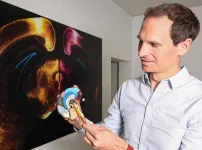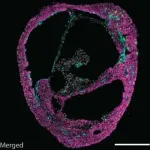Overcoming long-term trauma can be facilitated
2021-05-20
(Press-News.org) How the brain deals with trauma is complex, and it's intuitive to say that we, as humans, get over trauma differently depending on if it happened a long time ago or if it was recent. But what scientific evidence do we have about the way the brain deals with short-term versus long-term traumatic memories?
EPFL scientists have identified the specific regions in the brains of mice responsible for reprograming traumatic experiences towards safety, and the brain regions are indeed different and depend on whether the trauma happened recently or a long time ago. They found that they could facilitate the extinction of long-lasting traumatic memories by enhancing the activity of a primitive region of the brain called the nucleus reuniens. The results are published today in Nature Neuroscience.
"Traumatic memories are so emotionally charged that they are difficult to 'erase' or extinguish. Despite this fact, surprisingly little is known about these long-term traumatic memories," explains EPFL's Nestlé Chair Johannes Gräff, principal investigator of the study. "In our study, it's the first time someone has researched fear extinction at the brain circuit level for long-lasting traumatic memories."
In 2018, Gräff and his team identified the cells in the brain responsible for reprogramming long-term trauma towards safety, also in mice. The same cell that was activated during a traumatizing experience was also activated after therapy, indicating that the traumatized cell itself was reprogrammed towards safety, giving insight into how the brain deals with trauma at the cellular level.
But Gräff and his team wanted understand how traumatized brain cells were reprogrammed towards safety and if other regions of the brain facilitated this reprogramming. What they found was that the canonical extinction pathway for recent memories is not involved for the extinction of so-called remote or long-term traumatic memories.
The nucleus reuniens facilitates recovery
In the experiment, the mice underwent 'Pavlovian fear conditioning', in which they received an electric shock from the ground. A traumatized mouse expresses its fear by freezing, but after the therapy, the mouse regains confidence and normal mobility. One group of mice received therapy 1 day after the trauma, while another group received therapy 30 days later.
The scientists determined which brain circuits were active in both groups of mice. They found that a direct cortico-amygdalar pathway was active 1 day following the trauma, but after 30 days, an indirect pathway was active, one that was rooted in the nucleus reuniens.
"Interestingly, the activity in the reuniens peaked shortly before the mouse ceased to express fear. It's as if the activity in the reuniens anticipates the end of freezing," continues Gräff. "When we manipulated the activity of the reuniens, time-locked to these peaks, we saw that it was indeed important for regulating fear. So when we boosted the activity, the mice froze less. When we inhibited it, the mice froze more."
"That anticipation of when freezing ends is actually probably the most enlightening finding of our research from a purely technical perspective."
The results provide insight at the brain-circuit level as to why traumatic memories are persistent and harder to extinguish. They shed light on the brain mechanisms involved for recovering from long-term traumatic memories.
Turning this recent discovery into therapy for people suffering from post-traumatic stress disorder or other long-term traumatic experiences that affect mental health remains a challenge. In collaboration with a partner institute in the Netherlands, the scientists currently have approval to study similar brain mechanisms in humans.
INFORMATION:
Press kit: http://bit.ly/2021_Trauma
DOI: 10.1038/s41593-021-00856-y
Nature link (after embargo): https://www.nature.com/articles/s41593-021-00856-y
2018 story: https://actu.epfl.ch/news/the-neurons-that-rewrite-traumatic-memories/
2018 Press Kit: http://bit.ly/2018Trauma
2018 Youtube: https://youtu.be/vDd30ErlSVg
[Attachments] See images for this press release:

ELSE PRESS RELEASES FROM THIS DATE:
2021-05-20
Montréal, May 20, 2021--Researchers at the University of Montreal Hospital Research Centre (CRCHUM) and Yale University have succeeded in reducing the size of the HIV reservoir in humanized mice by using a "molecular can opener" and a combination of antibodies found in the blood of infected individuals.
In their study published in Cell Host & Microbe, the team of scientists, in collaboration with their colleagues at the University of Pennsylvania and Harvard Medical School, show that they were also able to significantly delay the return of the virus after stopping antiretroviral therapy in this animal model.
Humanized mice are generated from immunodeficient mice that don't have their own ...
2021-05-20
Realizing the potential of self-driving cars hinges on technology that can quickly sense and react to obstacles and other vehicles in real time. Engineers from The University of Texas at Austin and the University of Virginia created a new first-of-its-kind light detecting device that can more accurately amplify weak signals bouncing off of faraway objects than current technology allows, giving autonomous vehicles a fuller picture of what's happening on the road.
The new device is more sensitive than other light detectors in that it also eliminates inconsistency, or noise, associated with the detection process. Such noise can cause systems to miss signals and put autonomous vehicle passengers at risk.
"Autonomous ...
2021-05-20
Scientists from Queen Mary University of London and Rothamsted Research have used radar technology to track male honeybees, called drones, and reveal the secrets of their mating behaviours.
The study suggests that male bees swarm together in specific aerial locations to find and attempt to mate with queens. The researchers found that drones also move between different congregation areas during a single flight.
Drones have one main purpose in life, to mate with queens in mid-air. Beekeepers and some scientists have long believed that drones gather in huge numbers of up to 10,000 in locations known as 'drone congregation areas'. Previous research has used pheromone lures to attract drones, raising concerns ...
2021-05-20
What The Study Did: These preliminary findings using U.S. Centers for Disease Control and Prevention Vaccine Adverse Events Reporting System data in the early phase of societal COVID-19 vaccination using two messenger RNA vaccines suggest that no association exists between inoculation with a SARS-CoV-2 messenger RNA vaccine and incident sudden hearing loss.
Authors: Eric J. Formeister, M.D., M.S., of the Johns Hopkins University School of Medicine in Baltimore, is the corresponding author.
To access the embargoed study: Visit our For The Media website at this link https://media.jamanetwork.com/
(doi:10.1001/jamaoto.2021.0869)
Editor's Note: Please see the article for additional information, ...
2021-05-20
What The Study Did: Researchers assessed associations between prenatal, early postnatal or current exposure to secondhand smoke and symptoms of attention-deficit/hyperactivity disorder (ADHD) among school-age children in China.
Authors: Li-Wen Hu, M.D., Ph.D., and Guang-Hui Dong, M.D., Ph.D., of Sun Yat-sen University in Guangzhou, China, are the corresponding authors.
To access the embargoed study: Visit our For The Media website at this link https://media.jamanetwork.com/
(doi:10.1001/jamanetworkopen.2021.10931)
Editor's Note: The article includes funding/support disclosures. Please see the article for additional information, including other authors, author contributions ...
2021-05-20
BOSTON - Screening for colorectal cancer - the second most common cause of cancer-related death in the United States - can save lives by detecting both pre-cancerous lesions that can be removed during the screening procedure, and colorectal cancer in its early stages, when it is highly curable.
Screening is most commonly performed with endoscopy: visualization of the entire colon and rectum using a long flexible optical tube (colonoscopy), or of the lower part of the colon and rectum with a shorter flexible tube (sigmoidoscopy).
This week, the United States Preventive Services Task Force (USPSTF) lowered the recommended beginning age for screening from 50 to 45 for persons without a family history of colorectal ...
2021-05-20
The discovery of a new species of ancient turtle is shedding light on hard-to-track reptile migrations about 100 million years ago. Pleurochayah appalachius, a bothremydid turtle adapted for coastal life, is described in a new paper published by a multi-institution research group in the journal Scientific Reports.
P. appalachius was discovered at the Arlington Archosaur Site (AAS) of Texas, which preserves the remnants of an ancient Late Cretaceous river delta that once existed in the Dallas-Fort Worth area and is also known for discoveries of fossil crocodyliformes and dinosaurs. P. appalachius belonged to an extinct lineage of pleurodiran (side-necked) ...
2021-05-20
For many engineers and scientists, nature is the world's greatest muse. They seek to better understand natural processes that have evolved over millions of years, mimic them in ways that can benefit society and sometimes even improve on them.
An international, interdisciplinary team of researchers that includes engineers from The University of Austin has found a way to replicate a natural process that moves water between cells, with a goal of improving how we filter out salt and other elements and molecules to create clean water while consuming less energy.
In a new paper published today in Nature Nanotechnology, researchers created a molecule-sized water transport channel that can carry water between cells while excluding protons ...
2021-05-20
Self-organizing heart organoids developed at IMBA - Institute of Molecular Biotechnology of the Austrian Academy of Sciences - are also effective injury- and in vitro congenital disease models. These "cardioids" may revolutionize research into cardiovascular disorders and malformations of the heart. The results are published in the journal Cell.
About 18 million people die each year from cardiovascular diseases, making them the leading cause of fatalities globally. Moreover, the most prevalent birth defects in children pertain to the heart. Currently, a major bottleneck in understanding human heart malformations and developing regenerative therapies are missing human physiological models of the heart.
The research group of Sasha Mendjan established cardioids ...
2021-05-20
NEW YORK, NY (May 20, 2021)--The immune nature of kidney cancer stands out when compared to other cancers: More immune cells infiltrate kidney cancers than most other solid tumors, and kidney cancer is one of the most responsive malignancies to today's immunotherapy regimens.
But despite treatment, many patients with clear cell renal carcinoma--the most common type of kidney cancer--eventually relapse and develop incurable metastatic disease.
A new study shows that the presence of a rare and previously unknown type of immune cell in kidney tumors can predict which patients are likely to have cancer recur after surgery. These cells could even ...
LAST 30 PRESS RELEASES:
[Press-News.org] Overcoming long-term trauma can be facilitated




